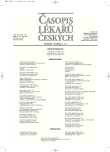Treatment of Hemosuccus Pancreaticus by Bilateral Embolization of Gastric Arteries
Authors:
V. Janík 1; R. Pádr 2; R. Keil 3; R. Lischke 4
; P. Pafko 4
Authors‘ workplace:
Radiodiagnostická klinika 3. LF UK a FNKV, Praha
1; Klinika zobrazovacích metod 2. LF UK a FNM, Praha
2; Interní klinika 2. LF UK a FNM, Praha
3; III. chirurgická klinika 1. LF UK a FNM, Praha
4
Published in:
Čas. Lék. čes. 2008; 147: 538-541
Category:
Case Report
Overview
Background.
Arosion of peripancreatic arteries in acute or chronic pancreatitis is a rare cause of bleeding into gastrointestinal tract – hemosuccus pancreaticus. Aim of the paper is to show the diagnostic and therapeutic options in this serious clinical stage.
Methods and Results.
We report a case of a patient with chronic pancreatitis who developed acute bleeding into the gastrointestinal tract due to the perforation of a pseudoaneurysm into pancreatic pseudocyst in the area of the pancreatic body. The diagnosis of hemosuccus pancreaticus, established by endoscopy and postcontrast CT examination, was confirmed by angiography. We stopped the acute bleeding from pseudoaneurysm, unusually well supplied by both gastric arteries by embolization of both arteries with metallic coils.
Conclusions.
Angiography plays an irreplaceable role in patients with hemosuccus pancreaticus.
Our case demonstrates bleeding from pseudoaneurysm supplied by both gastric arteries, whose embolization produced an immediate hemostasis and improvment the patient’s condition.
Key words:
hemosuccus pancreaticus, embolization, pancreatic pseudoaneurysm, pancreatic pseudocyst
Sources
1. Baltazar, E. J., Fischer, L. A., Frey, C.: Hemorrhagic complication of pancreatitis: radiologic evaluation with emphasis on CT Imaging. Pancreatology, 2001, 1, s. 3006–3013.
2. Dasgupta, R., Davis, N. J., Williamson, R. C. N., Jackson, J. E.: Haemosuccus Pancreaticus: Treatment by Arterial Embolization. Clinical Radiology, 2002, 57, s. 1021–1027.
3. Stosslein, F., Zimmermann, L., Bulang, T.: Embolization treatment of bleeding complications in pancreatitis J. Hepatobiliary Pancreat. Surg., 1998, 5, s. 344–347.
4. Wagner, J., Messmerl, P., Herzog, U.: Haemorhagische Pseudocysten und Pseudoaneurysmen bei Pancreatitis. Diagnostik und Therapie. Der Chirurg, 1998, 69, s. 48–54.
5. Sandblom, P.: Gastrointestinal Haemorrhage through the pancreatic duct. Ann. Surg., 1970, 171, s. 61–66.
6. Benz, C. A., Jakob, P., Jakobs, R., Reimann, J. F.: Hemosuccus pancreaticus: a rare case of gastrointestinal bleeding: diagnostic and intervetional radiological therapy. Endoscopy, 2000, 32, s. 428–431.
7. Suguki, T., Hatori, T., Imaizumi, T. et al.: Two cases of hemosuccus pancreaticus in which hemostasis was achieved by transcatheter arterial embolization. J. Hepatobiliary Pancreat. Surg., 2003, 10, s. 450–454.
8. Reber, P. U., Patel, A. G., Baer, H. U.: Acute hemorrhage in chronic pancreatitis: Diagnosis and treatment options including superselective microcoil embolization. Pancreas 1999, 18, s. 399–402.
9. Yamaguchi, K., Futagawa, S., Ochi, M. et al.: Pancreatic Pseudoaneuryzm Converted from Pseudocyst: Transcatheter Embolization and Serial CT Assessment Radiation. Medicine, 2000, 18, s. 147–150.
10. Kaman, L., Sanyal, S., Manekuru, S., Singh, R.: Pseudoaneuryzm of the Superior Pancreaticoduodenal artery, Rare Cause of Hemosuccus Panceraticus: Report of a Case Surg. Today, 2004, 34, s. 181–184.
11. Safiku, A., Iordache, S., Ciuream, T. et al.: Pancreatic Pseudoaneurysm of the Superior Mesenteric Artery Complicated with Obstructive Jaundice. A Case Report. Journal of Pancreas, 2005, 6, s. 29–35.
12. Stanule, B. E., Wilson, S. E., Debat, H. T.: Reduced mortality from bleeding pseudocysts and pseudoaneuzrysms caused by pancreatitis. Arch Surg., 1983, 118, s. 45–51.
13. Bender, J. S., Bouwman, D. L., Levison, M. A.: Pseudocysts and pseudoaneuryzmas: Surgical strategy. Pancreas, 1995, 10, s. 143–147.
14. Alavi, A., Ring, E. J.: Lokalization of gastrointestinal bleeding: superiority of Tc99m suflur colloid compared to angiography. AJR, 1981, 137, s. 741–748.
15. Korsak, J., Janik, J., Debski, J. et al.: Pseudoaneurysm of the gastroduodenal artery as a cause of obstructive jaudice. Med. Sci. Monit. 2001, 7, s. 759–761.
16. Maleux, G., van Steenbergen, W., Stockx, L. et al.: Multiple small pseudoaneurysms complicating pancreatitis: angiographic diagnosis and transcatheter embolization. Eur. Radiol., 2000, 10, s. 1127–1129.
17. Boudghene, F., L’Hermin, C., Igor, J. M.: Arterial complication of pancreatitis: Diagnostic and therapeutic aspect in 104 cases. J. Vasc. Interv. Radiol., 1993, 4, s. 551–558.
18. De Perrot, M., Berney, T., Buhler, L.: Management of bleeding pseudoaneurysmus in patients with pancreatitis. Brit. J. Surg., 1999, 86, s. 29–32.
19. Frey, C.: Angiographic embolization therapy of pseudoaneuryzm: Comment on Arterial complication of pancreatitis. Pancreas, 1993, 8, s. 742–746.
20. Sparrow, P., Asquith, J., Chalmers, N.: Ultrasonic-Guided Percutaneous Injection of Pancreatic Pseudoaneuryzm with Thrombin Cardiovasc. Intervent. Radiol., 2003, 26, s. 312–315.
Labels
Addictology Allergology and clinical immunology Angiology Audiology Clinical biochemistry Dermatology & STDs Paediatric gastroenterology Paediatric surgery Paediatric cardiology Paediatric neurology Paediatric ENT Paediatric psychiatry Paediatric rheumatology Diabetology Pharmacy Vascular surgery Pain management Dental HygienistArticle was published in
Journal of Czech Physicians

- What Effect Can Be Expected from Limosilactobacillus reuteri in Mucositis and Peri-Implantitis?
- Advances in the Treatment of Myasthenia Gravis on the Horizon
- Metamizole at a Glance and in Practice – Effective Non-Opioid Analgesic for All Ages
- Metamizole vs. Tramadol in Postoperative Analgesia
- The Importance of Limosilactobacillus reuteri in Administration to Diabetics with Gingivitis
Most read in this issue
- Duodenal Atresia and Stenosis
- Pregnancy and Delivery in Type II Hereditary Antithrombin Deficient Patients
- Feedings of Critical Care Patients by Endoscopic Three-luminal Tube – A Retrospective Analysis
- Rare Diagnosis of CD4⁺56⁺ Leukemia from Dendritic Cells Type DC2
